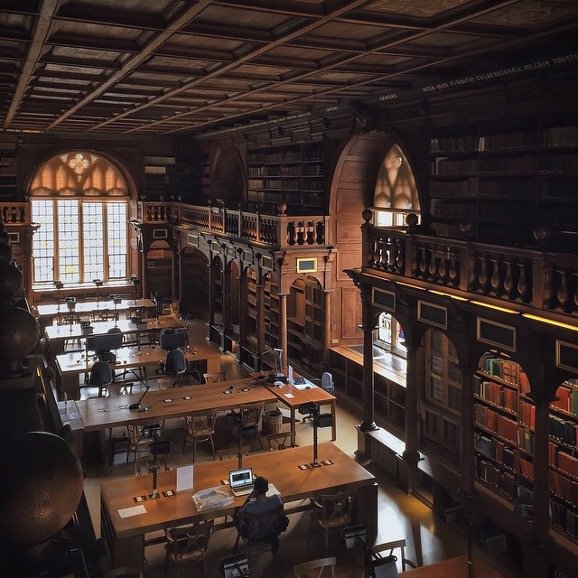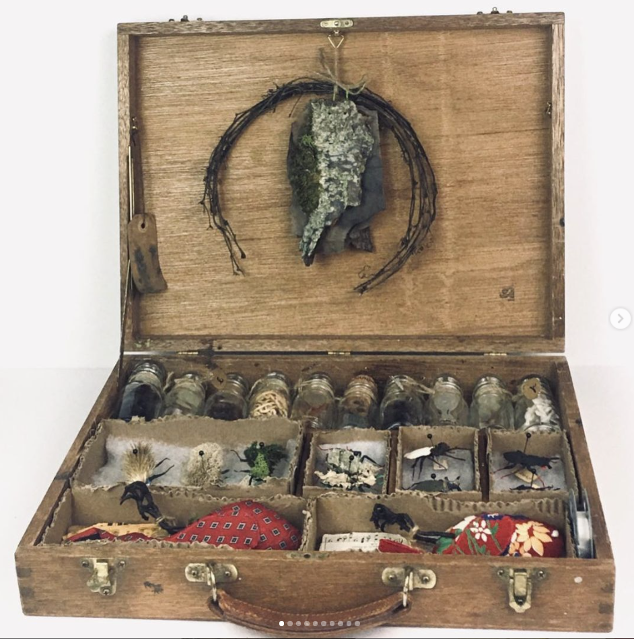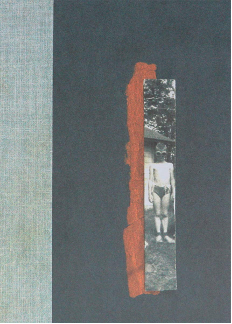by Kyrsten Myrup
So far this semester, we have devoted much time to learning about the technical process of bookmaking, including the historical origins of various book forms and bookmaking techniques. Complementary to this history is the survival stories of the books themselves—the institutions and individuals that have acquired them and preserved them through the ravages of time…
* * *
Sir Thomas Bodley (1545–1613) by unknown artist. © Bodleian Library, University of Oxford
« I hereby undertake not to remove from the Library, nor to mark, deface, or injure in any way, any volume, document or other object belonging to it or in its custody; not to bring into the Library, or kindle therein, any fire or flame, and not to smoke in the Library; and I promise to obey all rules of the Library. »
A far cry from the halls of Gorgas where sleep-deprived, coffee-toting undergrads stumble up and down the aisles—sending shivers down the spines of books and librarians alike—the Bodleian Library at the University of Oxford requires each new visitor to take the above oath prior to admittance. Originally recited in Latin, the text has been updated and translated into many languages and signing a letter can now replace the formal oath-swearing ceremony. However, the library’s tenet remains the same: to preserve its books for the benefit of generations to come.
The origins of the Bodleian Library date back to the year 1320 when a room in the University Church of St. Mary the Virgin became Oxford’s first library. The books, as was common throughout the Middle Ages, were literally chained to the shelves to prevent thievery. Over a century later, in the year 1437, the library would see its first major expansion when Humfrey, Duke of Gloucester (the youngest brother of King Henry V) made a generous donation of 281 priceless manuscripts to Oxford. Having outgrown its room, a new building was constructed for the library over the Divinity School, completed in 1488 and dubbed Duke Humfrey’s Library.
Duke Humfrey’s Library by unknown photographer. © Bodleian Library, University of Oxford
However, this library was to be short-lived and during the events of the English Reformation in the year 1550, Oxford’s Dean of Christ Church (the man responsible for the school’s religious college)—anxious to remove any trace of Catholicism from the school—cleared the library’s shelves, ordering some of the books burnt. (To this day, only three of the original manuscripts donated by Duke Humfrey can be found on the shelves of the Bodelian Library.) The erstwhile library was commandeered by the Faculty of Medicine and, for a time, Oxford lost its library. It was in this state of affairs that Sir Thomas Bodley came onto the scene in 1598.
Though his name would be immortalized by the library he restored in the last 15 years of his life, Bodley’s life experience during the preceding 53 years could fill volumes and was crucial to the success of the library he founded. Bodley was born into a wealthy Protestant family during the last year of Henry VIII’s reign. When he was only eight years old, the ascension of Mary I (dubbed Bloody Mary by the Protestants she persecuted) forced his family to seek sanctuary abroad, first in modern-day Germany and later in Geneva. While an adolescent in Geneva, Bodley received an exemplary education, including study of history and the classics as well as Hebrew, Latin, and Greek in addition to philosophy and religious education (John Calvin was living in Geneva at the time).
When the ascension of Elizabeth I to the throne in 1559 allowed his family to return to England, Bodley began his studies at Oxford’s Merton College, receiving his Bachelor of Arts in 1563. The next year he was admitted as a university fellow (equivalent in some ways to a grad student today) and soon became the first Greek lecturer at Oxford, one of many positions he would hold at the university over the course of his academic career.
By the mid-1570s, however, Bodley was ready for a change of scene. In his own words, he “waxed desirous to travel beyond the Seas, for attaining to the knowledge of some special modern tongues, and for the increase of [his] experience in the managing of affairs.” In 1576, Oxford granted him leave to go abroad. This sojourn in Europe, much like his first one, would yield dividends for his future.
When Bodley returned from Europe after four years abroad, he had become proficient in three new languages: Spanish, Italian, and French. Towards the end of his time abroad, he had already begun to carry out delicate missions for English ambassadors he encountered abroad. However, his diplomatic (read espionage) career would really take flight in the mid-1580s after he came to the attention of Queen Elizabeth.
In 1583, Elizabeth I, appointed him a gentleman usher, likely a cover for the clandestine missions he would be sent on in the service of the state. Two years later, the Queen sent him on his first major mission for the state, attempting to gain the support of a duke and the Danish king for the Huguenot Henry III of Navarre (the future King Henry IV of France) in the midst of the bloody Wars of Religion in France. In 1588, he would be sent solo into France itself with an oral message and a hand-written note from Queen Elizabeth to the King Henry III of France who was in hiding at the time.
In the midst of his missions during a brief return to England, Bodley married a wealthy widow, Anne Carey of Bristol. This alliance would be critical to his later efforts to restore Oxford’s library, which were funded largely via the fortune of Anne’s late husband. In 1588, Henry was sent to the Netherlands again as a resident diplomat, part of a long-term effort to persuade the United Provinces to defensively ally themselves against Spain. He would serve in this position for over nine years with only brief trips back to England.
Elizabeth I (the “Armada Portrait”) by the English School, 16th Century. © 2022 Royal Museums Greenwich
By his third year in the Netherlands, Bodley was hoping to be sent home and frequently requested to be recalled. Queen Elizabeth, insensitive to the many political intrigues he had to navigate while attempting to gain financial recompense from the provinces for the costs of war with Spain—including secret committees and intentionally drawn-out administrative delays—was often very unappreciative of his efforts.
When he was finally recalled to England in 1597, Bodley had become quite disillusioned and resigned permanently from diplomatic service. Ignoring at least three later attempts by the state to bring him out of retirement (which included a knighthood), he would leave a life of government service behind and embark upon a new effort: the restoration of a library at Oxford.
It is unclear exactly when Bodley first took up the idea of restoring a library at Oxford. As a former student and teacher there, he would have been acutely aware of the lack of a library and, according to his own narration of events, was “thoroughly persuaded, that in [his] solitude, and surcease from the Commonwealth affairs, [he] could not busy [himself] to better purpose, than by reducing that place (which then in every part lay ruined and waste) to the public use of students.” In 1598, he wrote a letter to the University, expressing his desire to undertake the restoration and renovation of the library, financially supporting the project via his own funds and important connections. His request was excepted and the effort was soon underway, making rapid progress.
Beyond restoring the existing library space and making plans for its future expansion Bodley donated more than 2,000 of his own books to the library, constituting the majority of the collections when the library first opened in 1602. Using his considerable social influence and diplomatic savvy, Bodley would secure many important donations in the years that followed from his friends and acquaintances and within three years, the collection had more than doubled. Seven years after Bodley’s death in 1613, the library contained more than 23,000 books.
Much of the long-term success of the Bodleian Library, from its founding in 1602 through the present day, can be directly attributed to Bodley’s innovative and revolutionary ideas about running a library coupled with staunch adherence to the library rules and regulations he established. One of these many innovations included the creation of a rich vellum-covered book, displayed in prominence in the center of the library, which included the name of every person to donate to the library. Successful from its outset, this is a practice employed in many libraries to this day.
Beyond the book donations provided by others, Bodley was able to use the generous monetary donations in addition to his own funds to carefully choose works he deemed would be vital to the collection. Unlike most of his contemporaries, Bodley’s literary interests extended far beyond classical European manuscripts. Through his efforts, the library secured Hebrew, Turkish, Persian, Arabic, Syriac, and Syriac.
Bodley also used important connections to buy expensive Chinese books from merchants of the Dutch East India Company, in spite of the fact that they were largely regarded as curios at the time and no one at the library could translate them for over two hundred years following their acquisition. The grand finale to Bodley’s book-collecting for the library was the agreement he made with Stationers’ Company of London to receive a free copy of every book they published, a precursor of the legal deposit system—used to archive a physical copy of all published books—used in Britain to this day.
In keeping with his sensibilities regarding the importance of having a diverse literary collection, Bodley also championed making the library accessible to all scholars, no matter their institution of origin. This was a very revolutionary concept at a time when the use of a certain institution’s library was mainly limited to the institution’s own professors and scholars and outside invitations were rare. Bodley also extended the library’s open hours to six hours a day—far more than the four hours a week typical of other libraries at the time—and prioritized the creation of a library catalog the benefit of all visitors.
Central to the survival of the Bodleian library was a policy enforced by Bodley which would seem contrary to the purpose of most libraries today. Visitors to the library were not allowed to check out books in any way but had to do all of their reading onsite. It was very common at the time for library materials to permanently disappear in this way. This policy was strictly reinforced after Bodley’s death causing the library to refuse the requests of such figures as Charles I and Oliver Cromwell among others, but at the same time enabling its many priceless collections to remain intact to this day.
Bodley left his final contribution to the library through the terms of his will. After devoting the last 15 years of his life to restoring a library to Oxford (and also writing a first-of-its-kind autobiography in the process) he passed away in 1613 at the age of 67. Two years prior, he had conceived a new plan to expand the library—financing the construction via his own funds and a well-thought scheme using the library’s existing assets—which would be carried out in the years following his death. While he did leave various smaller bequeathments to individuals, to the consternation of some of his family and friends (most especially, a brother and niece who would take his will to court—losing their case) he left the lion’s share of his fortune, some 7,000 pounds to Oxford and the library.
Bodley’s legacy lives on today in the Bodleian Library, the second-largest library in Britain and part of the larger Bodleian Libraries system which now houses some 13 million works, a large portion of which have been digitized. Among the works most prized by scholars in the Bodleian Library to this day are four copies of the Magna Carta, a 1455 Gutenberg Bible, the only surviving manuscript of the Song of Roland (written in Old French circa. 1130), the Ashmole Manuscripts (dating from the 11th through 17th centuries), and the Codex Bodley (dating back to pre-conquest Mexico).The library also houses one of the largest collections of premodern Chinese manuscripts in Europe.
* * *
While you may not be an Oxford scholar, you can access many of the Bodleian collections digitally (see links below). And you’ve likely seen the interior of the Bodleian Library. It provided one of the filming locations for the Hogwarts library throughout the Harry Potter film series.
Just for Fun…
Digitization of Bodley’s autobiography (first published in 1647), you can turn the pages and everything: https://archive.org/details/TheLifeOfSirThomasBodleyWrittenByHimself/mode/2up
Virtual Guided Tour of the Bodleian Library, make sure to scroll around: https://www.youtube.com/watch?v=M70H4M_pL4o
Search or browse the Bodleian Libraries Digital Collections: https://digital.bodleian.ox.ac.uk/browse/
Sources Cited:
https://www.oxforddnb.com/view/10.1093/ref:odnb/9780198614128.001.0001/odnb-9780198614128-e-2759
https://archives.bodleian.ox.ac.uk/repositories/2/resources/666
https://visit.bodleian.ox.ac.uk/plan-your-visit/history-bodleian
https://search.ebscohost.com/login.aspx?direct=true&db=nlebk&AN=1433166&site=ehost-live&scope=site
(MLA for above reference since it won’t be accessible without being logged into EBSCO via UA Libraries:
Patrick Lo, et al. Inside the World’s Major East Asian Collections : One Belt, One Road, and Beyond. Chandos Publishing, 2017.)

























